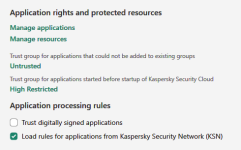rndmblk
Level 3
- Nov 18, 2020
- 94
Hi @Andy Ful
Is this comment referring to the settings outlined by @RoboMan here - Kaspersky's Application Control: what is it, how it works
The reason I ask is that I reinstalled KIS today and configured it in line with those settings (there are some slight window layout changes since 2019 but otherwise the same AFAIK):
1. Under Settings, open Application Control
2. Untick ‘trust digitally signed applications’ (due to possibility of stolen/bad certs)
3. Set ‘Trust group for applications that could not be added to existing groups’ to Untrusted
4. Set ‘Trust group for applications started before startup of Kaspersky’ to Low Restricted
Hope it's ok to ask here - I know this isn't the eKaspersky forum but I do use SWH so was interested in your comment.
Kaspersky with Application Control can be set to work similarly to Trusted Application Mode, so all executables and some popular script types run in the Untrusted group if they are unknown in KSN. Such settings + disabling the option which trusts applications that have a digital signature are sufficiently strong and do not require additional protection via SWH.
Is this comment referring to the settings outlined by @RoboMan here - Kaspersky's Application Control: what is it, how it works
The reason I ask is that I reinstalled KIS today and configured it in line with those settings (there are some slight window layout changes since 2019 but otherwise the same AFAIK):
1. Under Settings, open Application Control
2. Untick ‘trust digitally signed applications’ (due to possibility of stolen/bad certs)
3. Set ‘Trust group for applications that could not be added to existing groups’ to Untrusted
4. Set ‘Trust group for applications started before startup of Kaspersky’ to Low Restricted
Hope it's ok to ask here - I know this isn't the eKaspersky forum but I do use SWH so was interested in your comment.

